Egypt has long been one of those destinations we learn about as a child and usually only dream of visiting. Learning about the Pharaohs, hieroglyphics, the Pyramids, and the Sphinx tells us the stories of ancient civilizations from millennia past. With so much history to offer and incredible things to do, creating the perfect itinerary to visit the top Egypt landmarks can be a challenge.
*Disclaimer: This post may contain affiliate links. If you make a purchase through one of these links, I will earn a small commission. This occurs at no added cost to you.*
But if you are looking for an itinerary that takes you through the country’s highlights without the stress of the research, then read on to discover the best way to visit and experience the incredible history and culture that Egypt offers.
From the pyramids outside of Cairo to the temples in Luxor and Aswan, visiting Egypt allows us to appreciate the complexities of the people and their knowledge of engineering. Within these important centers and the Nile River, there are many things to do on an Egyptian vacation. Make no mistake, 14 days in Egypt will be exhausting!
Read on to discover how to spend 14 incredible days in Egypt.
Table of contents
- Where is Egypt?
- Getting to Egypt
- Egypt Landmarks and Historical Sites: Itinerary- Days 1- 3 – (Cairo)
- Egypt Landmarks and Historical Sites: Itinerary – Day 4 (Luxor & Valley of the Kings)
- Egypt Landmarks – Days 4 to 8- Nile Cruise:
- Egypt Landmarks – Day 10 – (Alexandria)
- Egypt Itinerary Days 11-14 Red Sea Resort (Hurghada)
- Egypt Itinerary – Day 14 Hurghada-(Cairo)
- Egypt Landmarks Summary
Where is Egypt?
Egypt is sometimes considered part of the middle east, but it is located in the northeast corner of Africa. It borders countries like Israel, Sudan, and Libya, with the Mediterranean Sea to its North and the Red Sea to its East. Commonly, trips to Egypt are combined with trips to Jordan or Saudi Arabia, as they’re all very close to each other.
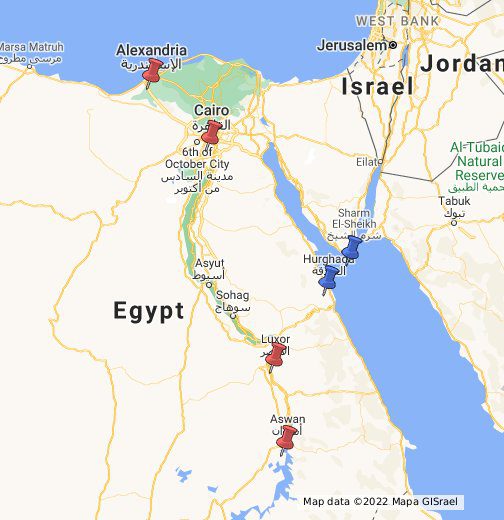
Getting to Egypt
The best way to get to Egypt is to fly. With Cairo being an international airport, there are many options for flights coming from North America, Europe, Asia, and the South Pacific. For the best rates and routings, you can try Google Flights or Trip.Com, or Cheap-O-Air. You can also investigate flying to an alternative airport such as Hurghada, which may have a great price from where you live. Domestic flights within Egypt are not expensive, and EgyptAir is quite reliable. For this article, I assume you will fly into Cairo to start your tour of the top Egypt landmarks.
Unlike other destinations, travelling by car or train is not recommended for Egypt due to security and lack of infrastructure.
For more information and travel tips before you go, check out the related articles on How to Plan Your First Trip to Egypt and 8 Egypt Travel Tips You Should Know Before You Go.
The following showcases some of the best things to do in Egypt to appreciate the oldest civilizations in the world. Nowhere else will you find pristine burial chambers, temples, and artifacts representing the lives and livelihoods of the ancient world’s famous rulers and royalty.
Egypt Landmarks and Historical Sites: Itinerary- Days 1- 3 – (Cairo)
Egypt Landmarks – Day 1 –
The first day of your Egypt will be getting to Cairo. Depending on your flight’s arrival, you may have some time to start exploring on your own, or you may want to stay around your hotel and rest. Taking the time to rest and acclimatizing yourself to the heat is a great option.
Choosing your hotel in Cairo is a personal preference based on your level of luxury, amenities, and price. Regardless of your accommodations, you will likely be joining tours to visit the incredible sights, so having tours that offer hotel pickup is a great option.
I recommend the Radisson Blu Hotel, Cairo Heliopolis, as a great starting point, as it has a great selection of amenities, including breakfast and a rooftop pool. If you prefer better scenery, the Cairo Marriott Hotel & Omar Khayyam Casino has a great mix of Egyptian character and a view of Cairo and the Nile River.
On a side note, you should bring earplugs for sleeping, as Cairo is known for its cars continually honking throughout the night.
Egypt Landmarks – Day 2 –
For your first full day in Cairo, I suggest heading over to Giza and seeing the Pyramids, the Sphinx, and the Grand Egyptian Museum for the start of your Egypt itinerary. Visiting the pyramids is the most common reason to visit Egypt as it has the most famous Egypt landmark. It is hard to imagine the incredible history of these enormous man-made structures until you are in their presence. Seeing them on tv or video does not do them justice! It is best to take a guided tour in this area as you will want to hear about the history of why they were built, how they were made, and why they are such a valuable piece of Egyptian history.
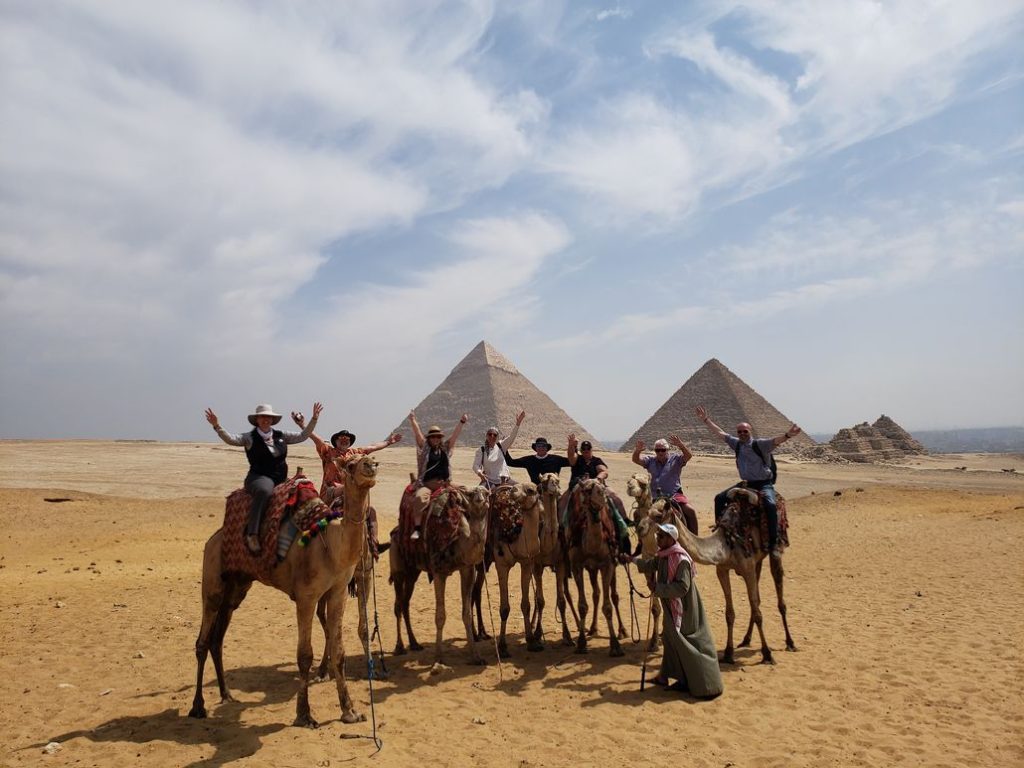
Entrance fees for the Pyramids are 200 LE (Egyptian Pounds) per person. If you want to go inside the main pyramid, it is an additional fee of 400 LE. If you do not, that is fine. It is an interesting walk around the perimeter with plenty of scenery and the remains of other temple areas. Go as early in the day as possible as this incredible site does get busy during the day. It is also very HOT, so plenty of water, sunscreen and a hat are a must.
Within the pyramid complex, there are opportunities to tour on either horse, carriage, or camel. I recommend the camel ride as it adds to the authentic Egyptian experience. If you have never ridden a camel, you will discover that part of the challenge is staying on the beast as it rises from the ground. All kidding aside, the camel ride is a great way to experience what life in the desert was like. Your camel guide will take you to an area where you can have your photo taken with the pyramids in the background.
Camel rides vary in length and cost, but typically a 30-minute ride is about 100 LE or $25 USD. Be sure to agree on the price before you get on, as scams with these guides can be prevalent.
Plan on spending between 2 and 4 hours at the Pyramid complex to discover and appreciate the history and engineering feats of the ancient Egyptians.
The next stop on your Egypt landmark tour should be the Sphinx, as it is not too far from the pyramids.
The Sphinx is a colossal limestone sculpture of a mythological creature with a lion’s body and a human head. It is believed that it was created to act as a sentinel for the pyramid complex. Unfortunately, the statue’s stone has suffered great damage over the years due to environmental pollutants and climatic factors. Regardless, seeing this massive structure lying with the pyramids in the background is nothing short of amazing! We have all seen the photos, but they are different from the real thing.
Depending on your guide and the time of day, you can experience the evening Light Show at the Pyramids. Here, near the location of the Sphinx, there is a small grouping of benches for the best viewing of this spectacular.
A trip to the Egyptian Museum of Cairo would be a great way to head out of the heat for the rest of the afternoon. The Egyptian Museum is the oldest archaeological museum in the Middle East and houses the world’s most extensive collection of antiquities from the eras of the great pharaohs. Opened in 1902, it has become a top Egypt landmark in downtown Cairo and is home to some of the most magnificent masterpieces.
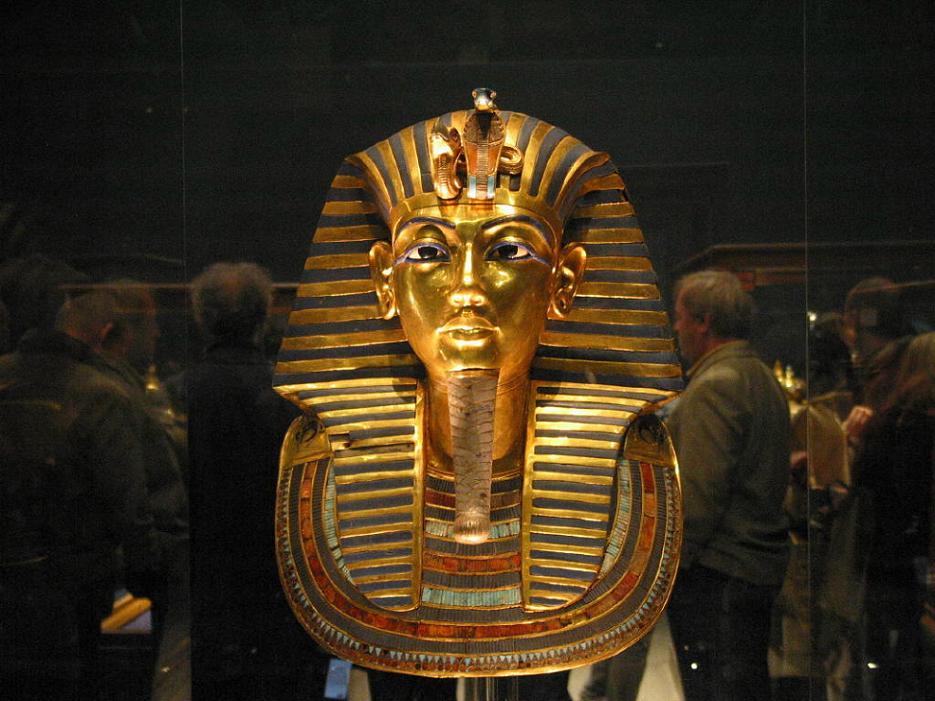
Artifacts within the museum’s collection include the complete burials of Yuya and Thuya, Psusennes I and the treasures of Tanis, and the Narmer Palette commemorating the unification of Upper and Lower Egypt under one king. Numerous other artifacts and statues are distributed throughout these hallowed walls.
A visit to this museum should not be taken lightly as there is so much to see, read and understand about these creators of ancient Egypt. Entrance fees for foreigners are around 200 LE (Egyptian Pond) and opening hours are 9:00 am to 5:00 pm.
It should be noted that the new Grand Egyptian Museum is presently in the final stages of completion on the Giza Plateau. It is estimated that this state-of-the-art museum should open sometime in 2023 and will be a great addition to the tourist experience on the Giza Plateau. On the downside, many artifacts have already been transferred from the Egyptian Museum to the Grand Egyptian Museum, so the older site is starting to look somewhat scarce. Rest assured, there is still plenty to see during an afternoon visit.
Egypt Landmarks – Day 3 –
For the second full day in Cairo, I suggest heading to some of the Egypt landmarks and other museums in the downtown areas. Some of these could include the following:
- Khan el Khali Markets
- Coptic Cairo
- Mosque of Muhammad Ali
- Visiting the Royal Mummies at the National Museum of Egyptian Civilization (NMEC)
- The Citadel
- Museum of Islamic art
You can find more details in my related post, Outstanding Things You Need to See in Cairo, Egypt.
Are you ready for the overnight train ride from Cairo to Luxor?
The next part of your fact-filled 14-day Egypt itinerary will have you heading to the train station in Giza or Cairo. This will depend on how you have chosen to spend your day touring the ancient sites. It does not make that much of a difference where you start but keep in mind that the station in downtown Cairo may be busier.
It is said that taking this overnight train is like a rite of passage, and it should be part of everyone’s itinerary. The journey goes through some of the old settlements on its 504 km journey to Luxor. But there are a few things you need to know about the trip itself.
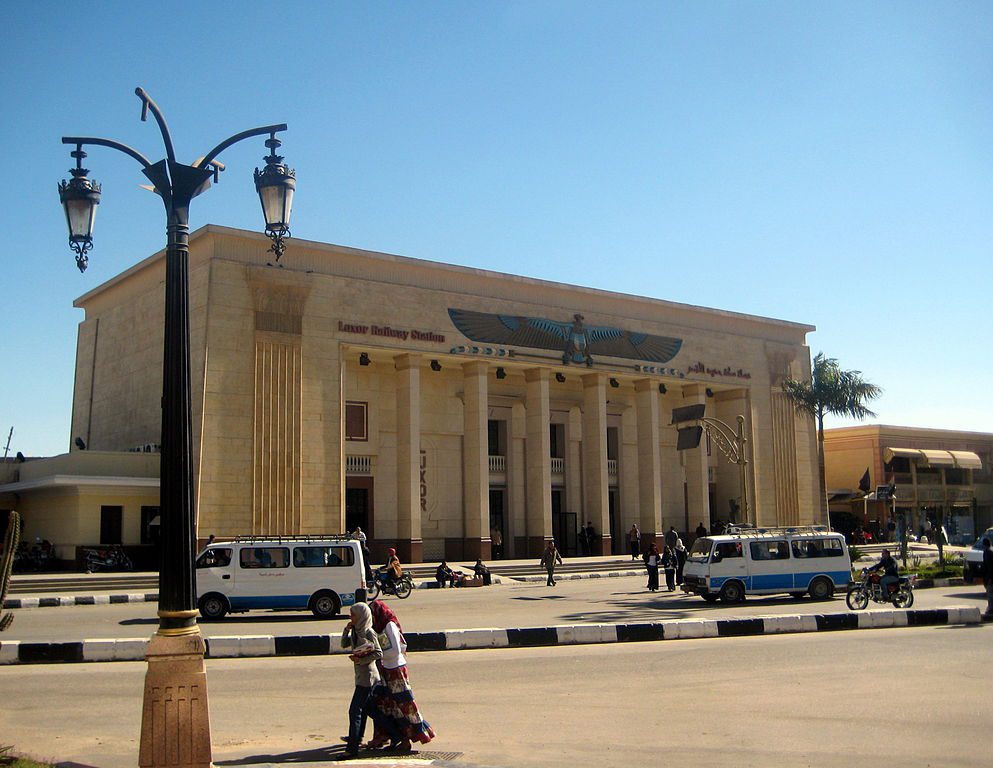
Firstly, as its name states, it is an overnight journey. So, if you hope to catch a glimpse of local Egypt life, you will be disappointed. Aside from a few lights at the multiple station stops along the way, the route has you in parallel with the river Nile, and for the most part, the trip is in the dark.
Secondly, it is a rough ride. The train tracks need some maintenance, and on more than one occasion, I thought we were about to derail.
Food on the train is another thing. Not great.
If you are interested in a detailed account of this experience, you should read my post on the Overnight Train from Cairo to Luxor – The Worst Must-do Experience.
Whether you have a good experience or a bad one, either way, the train ride will have you arriving in Luxor on Day 4 to further explore and experience some incredible Egyptian landmarks.
Egypt Landmarks and Historical Sites: Itinerary – Day 4 (Luxor & Valley of the Kings)
Now that you have arrived in Luxor, you will probably head to the Nile Cruise ship to drop off your luggage. Once your luggage is safely stowed onboard, your tour will commence into Luxor and the Valley of the Kings.
The visitor’s center at the Valley of the Kings entrance is quite impressive. Spacious, clean, and air-conditioned, it provides many displays and models of the Valley of the Kings. The history of the excavation is also prominently displayed. Your guide will likely be able to elaborate on some of the information.

Leaving the rear of the building, you will board a trolly train to take you to the burial places within the valley. There are over 65 tombs unearthed in the Valley of the Kings, but only a few are open to the public. As of July 2022, these are the tombs available for public viewing:
- Ramesses VII
- Ramesses IX
- Merenptah
- Ramesses III
- Tausert-Setnakht
- Seti II
- Ramesses I
- Siptah
The most common ticket purchased will give you entrance to three of the temple/burial chambers. You can visit Ramesses V & VI, Seti I, or Tutankhamun for an extra fee.
There is a boardwalk to help you walk through the uneven ground toward sites.
There are a few words of caution for this area. It is VERY hot so a proper sunhat, sunscreen and plenty of water should be carried with you. There are also very few places to sit and rest. Many of the entrances to the tombs have steep, uneven stairs, so people with mobility issues may have problems accessing these tombs.
Visiting here in the Valley of the Kings will typically last 2-3 hours.
Nearby is another one of the greatest Egypt landmarks, that being the Mortuary Temple of Queen Hatshepsut. A visit to this burial place often follows the valley of the Kings visit. The temple’s walls are painted with beautiful murals depicting rituals, festivals, and the transportation of obelisks to their destination at the Karnack temple.
A visit here is usually relatively short, around 30-40 minutes.
Egypt Landmarks – Days 4 to 8- Nile Cruise:
Egypt Landmarks – Day 4 – (Luxor – Esna – Edfu)
Following your morning visit in Luxor and perhaps a nice lunch along a river restaurant, you will board your cruise ship to head off for a few days of tranquility along the Nile.
For a detailed account of what to expect on a Nile Cruise itinerary, see the related post “Nile Cruise Itinerary – Exploring the Best of Egypt’s Temples in 5 Days“.
Throughout the afternoon, you will experience life along the Nile. Several villages are seen along the way, with many fishermen or farmers demonstrating their way of life. Children are often found waving and calling to the cruise ships as they pass along the river. In the evening, you will pass through the locks at Esna and make your way to Edfu.
Egypt Landmarks – Day 5 – Nile Cruise: (Edfu – Kom Ombo – Aswan)
Edfu is the second largest temple in Egypt and is dedicated to the god Horus. Construction of this temple was started in 237 BC but not completed until 57 BC. It is one of the best-preserved temples in Egypt and is an excellent example of traditional Egyptian elements mixed with Greek influences.
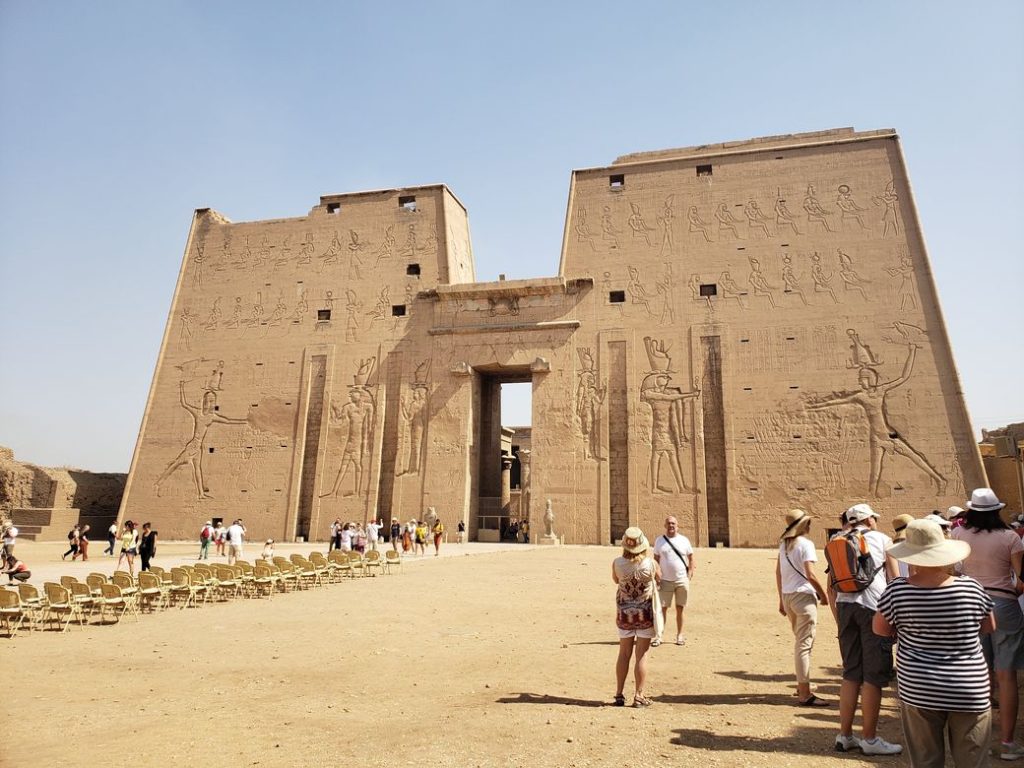
A visit to this famous Egyptian Landmark is typically about 1.5 to 2 hours and is reached by horse-drawn carriage from the banks of the Nile.
The rest of the day is spent basking in the relaxed glory of cruising the historic Nile and watching the villagers and wildlife go by. Look carefully; you might even see some water buffalo wading along the shores.
Shortly after dinner, you will arrive at the temple of Kom Ombo for an intriguing night-time visit. Well-lit to highlight some of the best features, this temple is well laid out and worth exploring every corner. This temple is unique because it was built out of a conflict between Sobek and Horus, and the ancient Egyptians felt it necessary to separate their temple spaces. Everything is in duplicate.
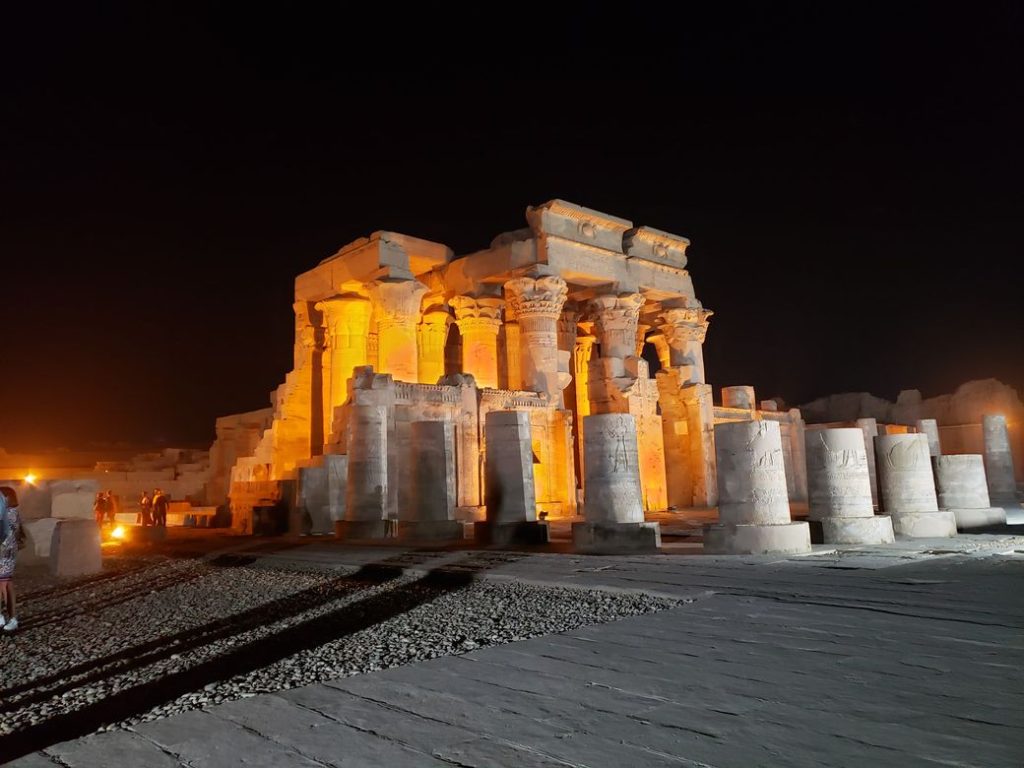
A visit stop here also includes a quick trip to the Crocodile Museum, located at the exact location where mummified crocodiles are well-preserved.
Egypt Landmarks – Day 6- Nile Cruise: (Aswan – Abu Simbel)
After cruising the night, you arrive in the city of Aswan. If you have booked an early trip to see the incredible site of Abu Simbel, you will have departed in the pre-dawn hours.
The temple of Abu Simbel is an Egyptian landmark known as an engineering marvel, both past, and present. In ancient Egypt, the Egyptians built this temple so that the sun shines into its innermost sanctum at a specific time of the year, highlighting the gods of Rameses, Ra-Horakhty, and Amun with Ptah, who represented the underworld, in a shadow.
In modern times, this temple was physically moved piece by piece to preserve it during the construction of the Aswan High Dam. If it had not been moved, the temple of Abu Simbel would have been lost under about 200 feet of water.
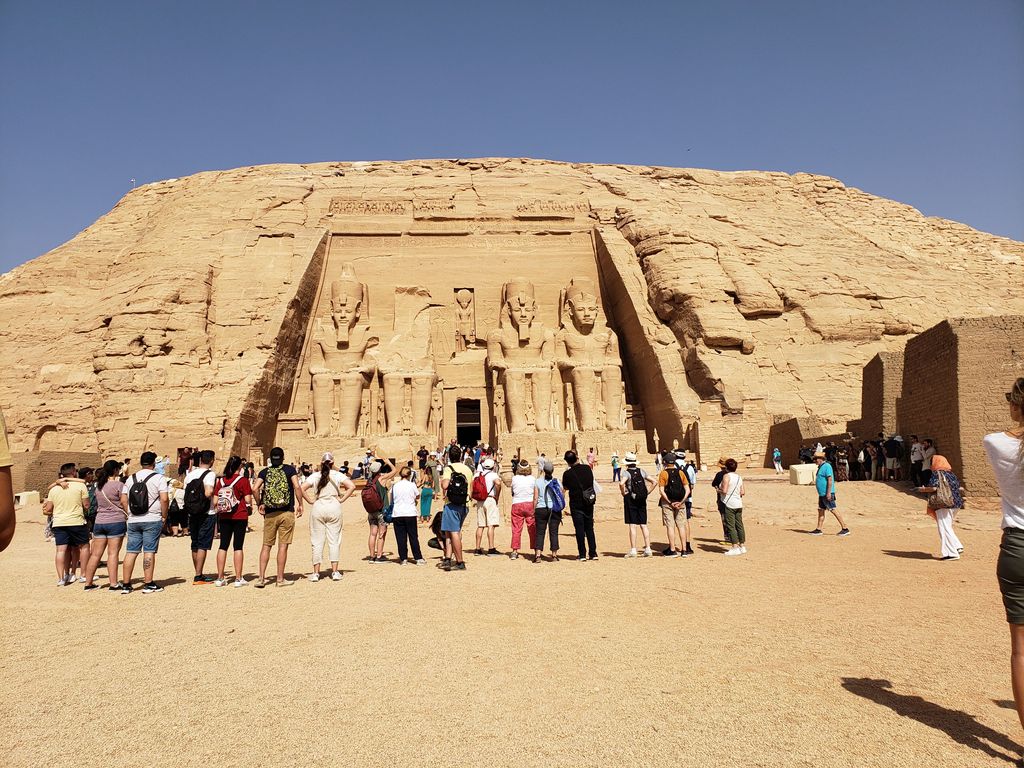
For a more detailed guide to visiting the Abu Simbel, see the post “Day Trip to Abu Simbel – The Greatest Temple Near Aswan.“
If you have some spare time in the afternoon after returning from Abu Simbel, take a tour of the Aswan High Dam. You are not permitted to go inside, but it is worth seeing this incredible site that both positively and negatively disrupted the Nile River valley.
If shopping is required, Aswan is known for teas, spices, perfumes, and incense. Be sure to have sealed packaging to bring home through customs.
Day 7 – Nile cruise: (Aswan-Luxor)
On many Nile cruise itineraries, you will visit a few sites in Aswan before heading back to Cairo, either by plane or overnight train. On this two-week journey to see the best Egyptian landmarks, the cruise continued back along the Nile to Luxor to visit more sights.
In Aswan, there are several important sites to visit. The Philae Temple, like Abu Simbel, was also moved to prevent flooding from the construction of the Aswan High Dam, and it is now located on an island in the middle of the Nile. Here, it is believed that the Philae temple was built in 690AD to honor Isis, the wife of Osiris, and as such, represents one of the last temples created in the classical Egyptian style. It is considered one of the most sacred temples by the Egyptians and the Nubian people who resided in the area. It is quite a fascinating, open temple with plenty of towering columns lining the courtyard.
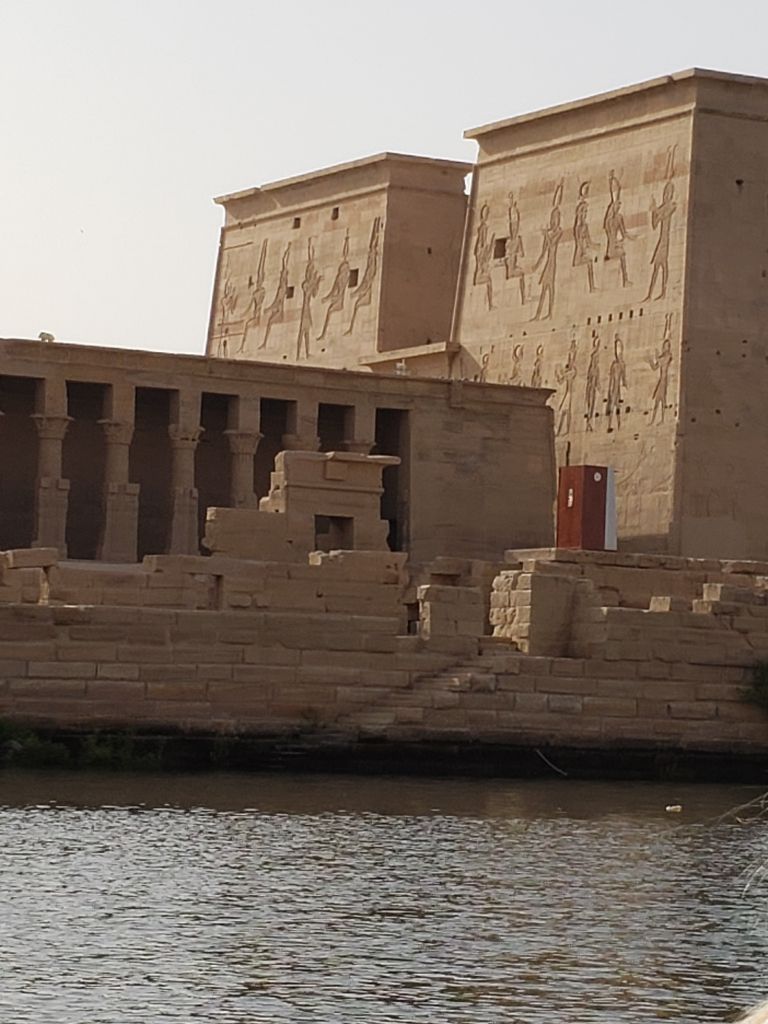
A visit to this temple can only be made by boat, which takes about 10 minutes.
A second common stop in Aswan is the Unfinished Obelisk. This is by far the most giant obelisk ever constructed, but unfortunately, it was never completed. This Egyptian landmark was supposed to be dedicated to Queen Hatshepsut and placed in the Karnack Temple in Luxor. Unfortunately, large cracks developed, which made it impossible to remove without fracture. Today, the obelisk lies in an open-air museum to demonstrate the sheer size of these monuments. The methods used to remove these obelisks are explained at the site’s visitor center.
A visit here usually takes about 30-45 minutes, allowing you time to climb through the quarry and read the history at the prominently displayed visitor center boards.
If you have some spare time in Aswan, be sure to take a felucca ride. A felucca is a traditional Egyptian sailboat, and typical tour is around two hours and sails in a loop around the islands of the central Aswan area. It gives excellent views of the encroaching desert dunes of the west river bank, the lush palm-tree-scattered islands, and the city on the east bank.
On this particular cruise, we returned to the boat to enjoy a “sea” day cruising on the Nile on our way back to Luxor.
A hot air balloon flight is often offered very early in the morning when you arrive in Luxor. If you are trying to decide if this trip is worth it, check out my related post: Luxor Balloon Flight – Is it Worth the Hype?
Day 8 –(Luxor)
Whether you start the cruise in Luxor or Aswan, you will undoubtedly have a second full day in Luxor. One day is spent in the Valley of the Kings on the west side of the river while a second day is spent on the east side. The two most popular sites on the east side of the Nile are the Karnak Temple and the Luxor temple.
Karnak was built and added over 2000 years. It started with the Set, Rameses, Tut, and many more. Every pharaoh made an addition to the temple. Some, like Tut, left just one statute, and Hatshepsut left a giant obelisk (copied in Washington, D.C.) Rameses II left over 100 columns. Another pharaoh left a reflecting pool (shallow pond) (also reproduced in Washington). Another pharaoh left a luck cube. The story goes that you turn around three times for luck, five times for love, seven times for money, etc.
A visit to Karnak is usually 2 – 3 hours as it is of pretty significant size. Often a return visit is arranged in the evening for a Sound and Lights show illuminating Egypt’s history and the significance of this temple.
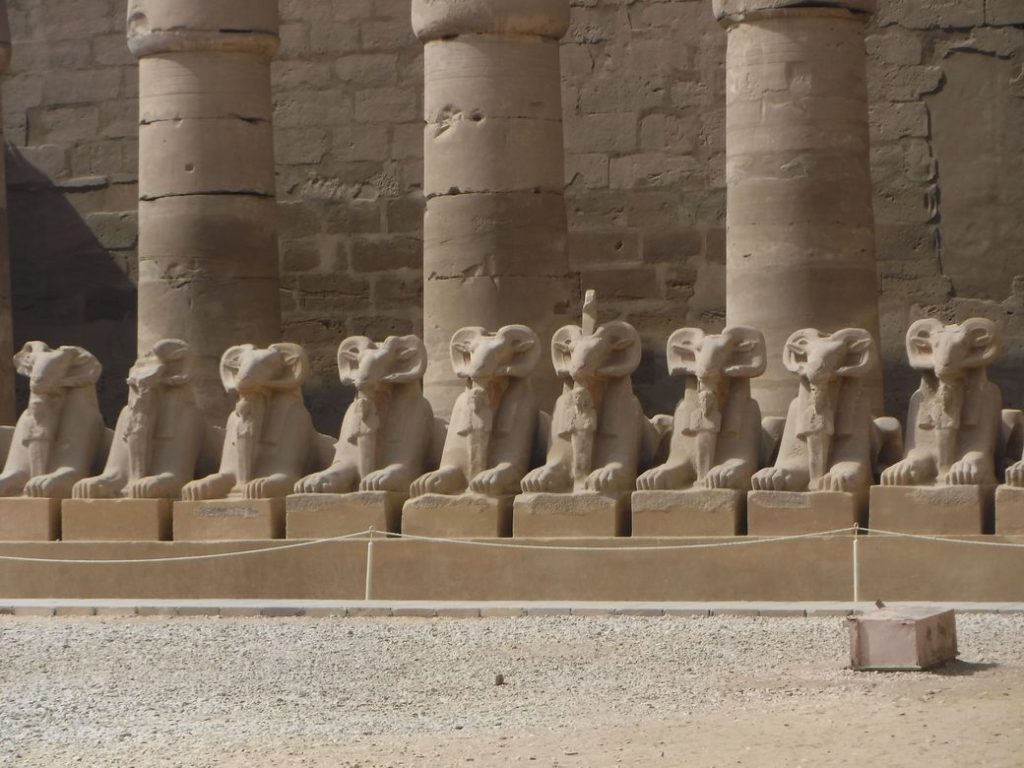
Luxor Temple is another one that Rameses II built to honor himself. Statues outside are more than 50 feet tall. Luxor temple has markings from the Greeks and Romans as well. The Romans changed the inner sanctum of this Egyptian landmark to a Roman Church, and the Greeks left a fresco which is still there. There is also a Christian Church built around 400AD and a Muslim Mosque built around 1200AD, which is still in use. Since there have been five different religions worshipping on this site, it is the oldest continually occupied temple/church for more than 4000 years.
Luxor temple usually takes about an hour to visit. Be sure to look down the Avenue of the Sphinxes, where more than 1000 statues line the road between Luxor and Karnak temples.
After visiting these two temples, many other sites in Luxor can be seen but for many, seeking out your hotel to rest is high on the list. After all, you will not want to miss going to the Night Markets in Luxor in the evening.
Here are some great suggestions for hotels in Luxor:
One of the best places to stay in Luxor is the Hilton Luxor Resort & Spa. This 5* resort is on the banks of the Nile overlooking the Valley of the Kings. With a tour desk on-site, visits to the local attractions can be arranged for a nominal fee.
The Steigenberger Nile Palace Luxor – Convention Center is right in the heart of Luxor and provides stunning views of the Nile. The Luxor temple is a short walk away as well as the shopping district.
The Pavillion Winter Luxor Hotel offers a blend of Egyptian heritage and French luxury nestled in lush gardens along the Nile. It is steps away from the Luxor Museum, the Luxor Temple, and the marketplace. Tours to the valleys of the Kings and queens can be arranged.
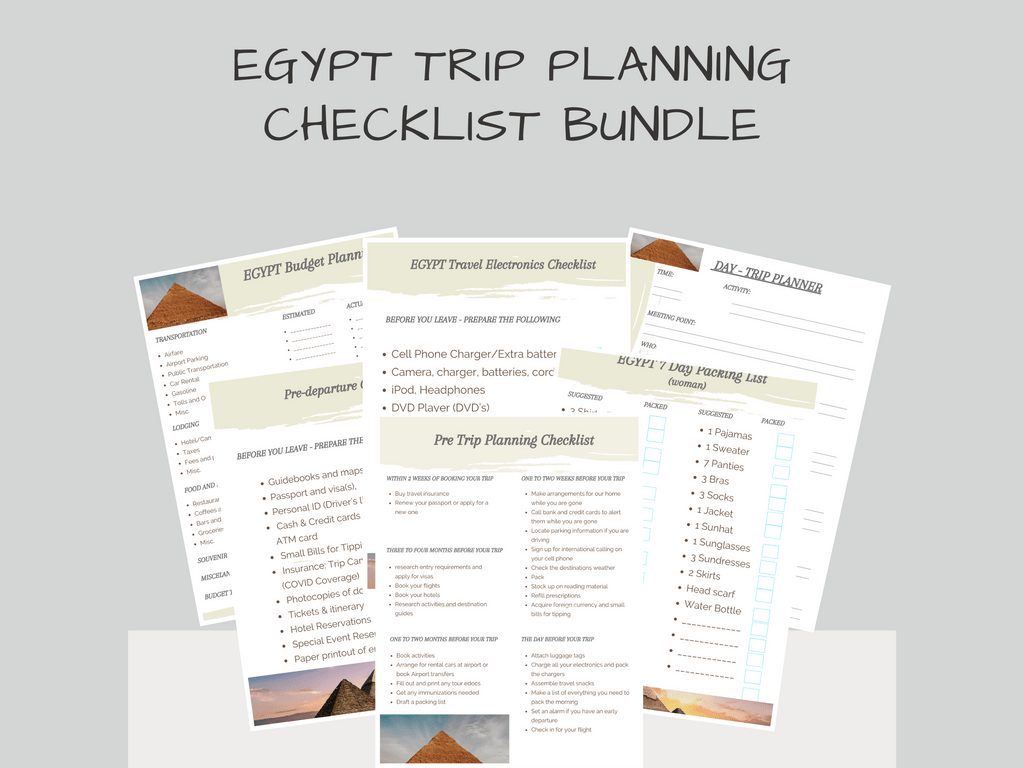
You might be interested in this travel aid to help you plan your trip to Egypt.
The Egypt Trip Planning Checklist Bundle is the best way to keep everything organized.
Egypt Landmarks- Day 9 –(Luxor-Cairo)
This is typically a travel day back to Cairo, but it is also the point in your Egypt itinerary where you need a bit of a break. You probably have been so busy absorbing all the culture and history that you have forgotten to relax. Be sure to book your return flights back to Cairo in the afternoon so that you can enjoy a relaxed morning at your hotel before you head out. If your hotel is along the Nile, be sure to view the morning boat traffic and fisherman along the river.
Typically, your flight back to Cairo is about one hour, and that will leave plenty of time to get to your hotel and go out for another Cairo adventure. Perhaps some evening markets would interest you? But be sure to get a good night’s sleep (if you can), as you will be up early for a day trip to Alexandria.
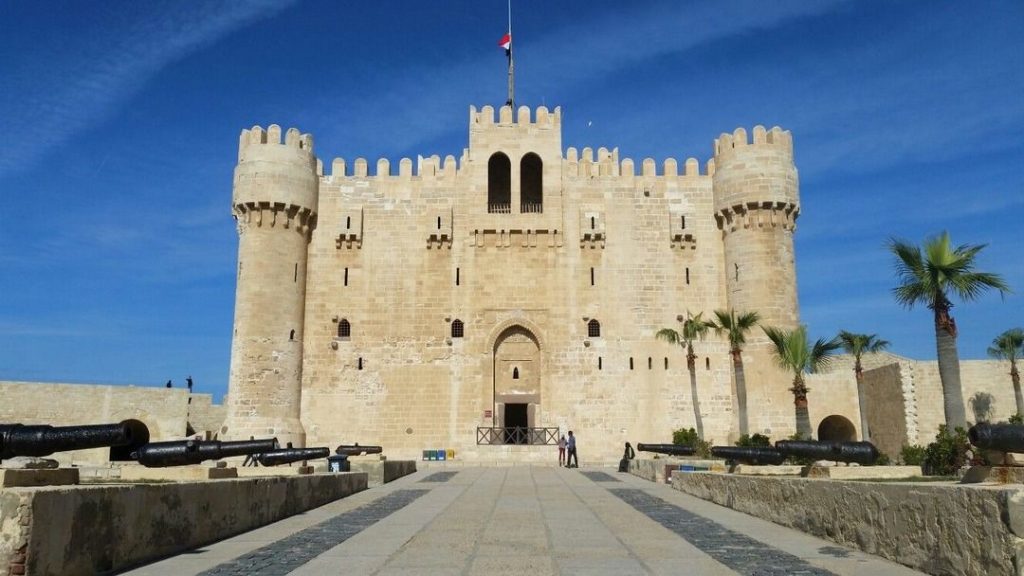
Egypt Landmarks – Day 10 – (Alexandria)
People who come to Egypt for a short duration usually see Cairo, Luxor, and Aswan. But if you have the time, taking the day trip to Alexandria is worthwhile.
Alexandria is located along the northern coast of Egypt on the Mediterranean Sea and can be reached by bus or train, but the best way to experience it is to take a guided tour directly from Cairo. Your guide will be able to bring to you the best Egyptian landmarks of this picturesque seaside community and explain their significance within one of Egypt’s most important trading centers.
The most popular sites here are the Citadel, the Library, the Catacombs, and the amphitheater.
For a detailed account of reasons to visit Alexandria and what to see, visit 10 Reasons Why a Day Tour to Alexandria from Cairo is Worth it.
For many, Egypt is an incredible experience! But it does come with a cost. Egypt is such a diverse country and culture that offers so much wonderful history. When we visit for the first time, we often want to see everything. However, this desire to absorb it all tends to exhaust us, and after seven to 10 days of GO-GO-GO, we need a break.
One of the best ways to incorporate this break into our Egyptian experience is to spend some time relaxing at a Red Sea resort. The Red Sea offers warm weather, beautiful sand beaches, blue waters, and incredible diving and snorkeling. Some sights include Hurghada Markets and Souks, Marine Museum and Aquarium, and visiting the Giftun Islands.
From Cairo, Hurghada is one of the best options for a relaxing break. A flight from Cairo to Hurghada is about one hour, and flights are very regular with Egyptair.
Egypt Itinerary Days 11-14 Red Sea Resort (Hurghada)
Staying at a Red Sea resort following your busy tours through Egypt’s past will reward you with the relaxation that a vacation should offer.
Depending on your travel style, budget and interests, there is plenty to do at one of these resorts or nothing at all.
If I had to recommend one activity, it would be the Hurghada Desert Safari. This is an exciting quad-bike tour through the Sahara Desert. For more information on what to expect on this tour, check out this article Hurghada Desert Safari: What to expect on a Quad Bike Adventure.
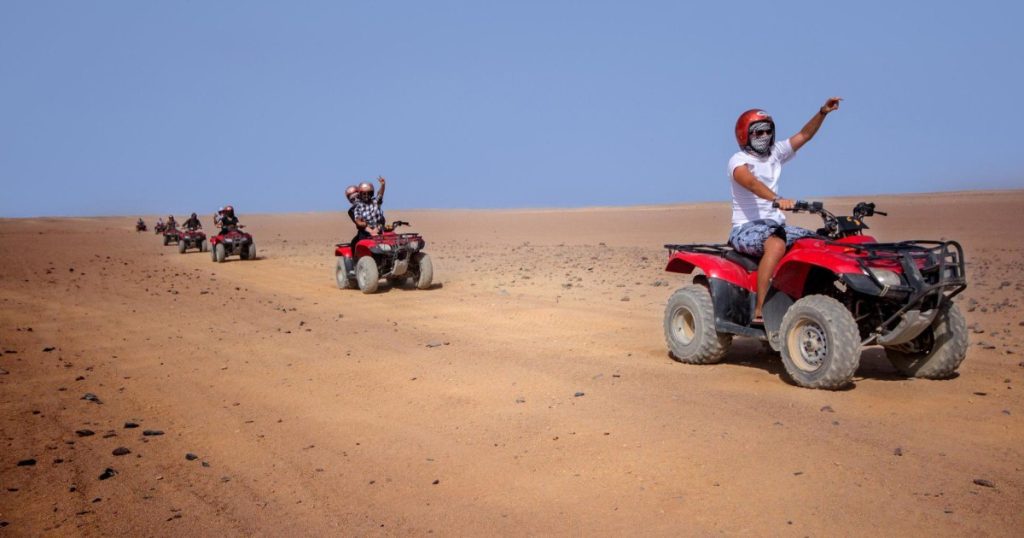
Egypt Itinerary – Day 14 Hurghada-(Cairo)
Depending on your flight times, you should be able to coordinate your flight from Hurghada back to Cairo on the same day as your return flight back to your home or onward travel destination. Hey, if you are already in the airport, take advantage of it.
Egypt Landmarks Summary
As you can see, Egypt is rich in the incredible history and has some fantastic attractions that must be seen to be appreciated! With a 14-day itinerary, you will have enough time to see the best Egyptian landmarks in history, as well as a bit of the desert and a swim in the Red Sea.
This suggested itinerary will help you plan your trip of a lifetime to ancient Egypt. If you have any questions, drop them in the comment section!
If you’d like to support this blog & help fund the cost of researching & maintaining the site, donations are accepted here. We appreciate all the help & support received from our readers so far!

Thanks for reading this post, I hope you enjoyed it! If you did, why not share it with your friends?



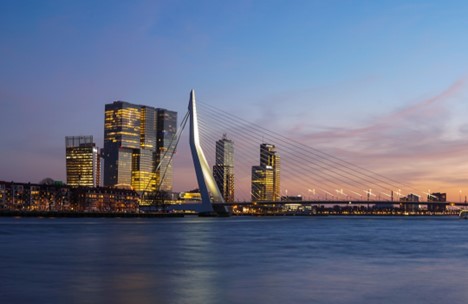

Great itinerary. It’s helpful to know the approximate times it takes to visit each of these sites, especially when there are so many things to see.
I find Egypt so fascinating! Love this two-week itinerary!
What a spectacular trip! I have major travel envy. I will be saving your whole series for future planning!